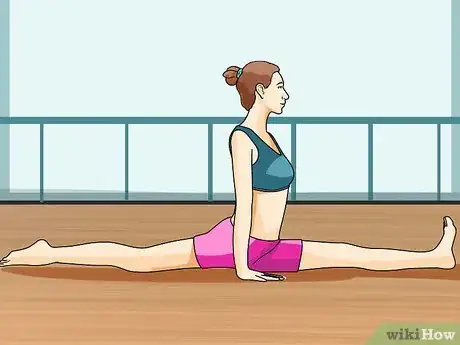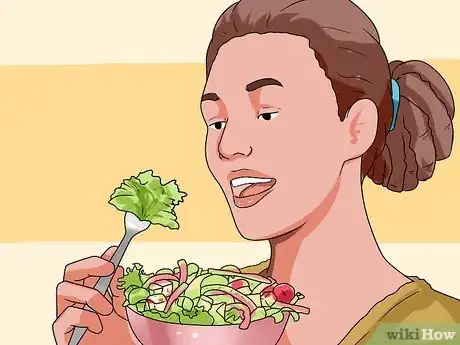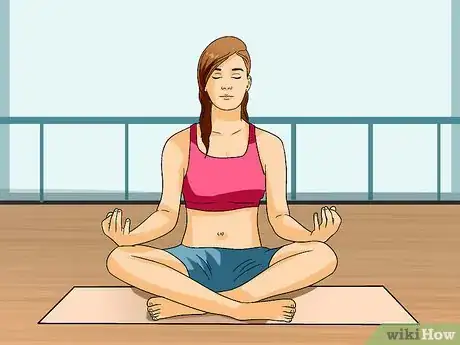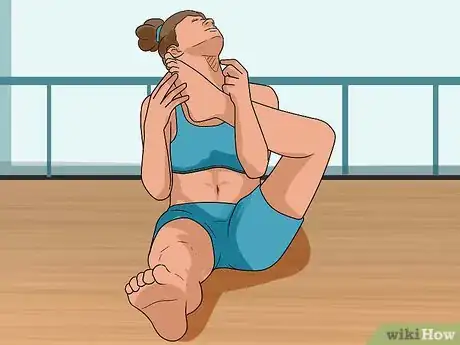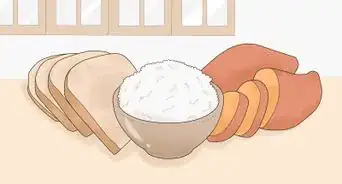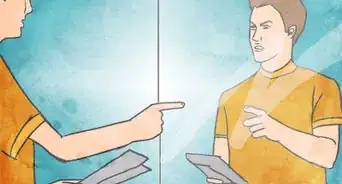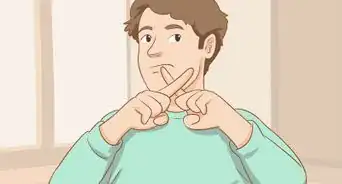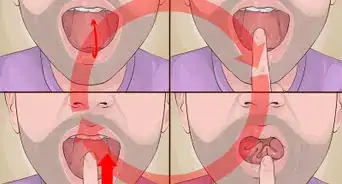wikiHow is a “wiki,” similar to Wikipedia, which means that many of our articles are co-written by multiple authors. To create this article, 20 people, some anonymous, worked to edit and improve it over time.
This article has been viewed 203,407 times.
Learn more...
You want to put your legs behind your head! Be patient. This is not something that you'll likely be able to do overnight. You'll need to build up your flexibility, first, so that your body is prepared to contort into such a complex position. Read on to learn specific ways that you can build up to putting both legs behind your head.
Steps
Building Flexibility
-
1Improve your leg flexibility. Stretch for at least 10 minutes each day – you can do this in one large chunk, or in several separate sections.[1] Stretch after a physical activity like dancing or running. The more flexible you are, the easier it will be to put your legs behind your head.
- Start the first day with a 10-second front lunge on both feet. Put one foot out and kneel with your back leg out. Push your hips forward, switch legs, and repeat.
- Do a 10-second butterfly stretch. Sit on the floor or ground and bring both of your feet together. Then, pull your feet towards your body, and bring your head as close to your toes as possible.
- Perform a 20-second star-watching stretch. Kneel with your rear off of your feet. Reach upward and backward, and try to touch your toes. Push your torso up and look at the ceiling or sky. Increase your time 5 seconds everyday.
-
2Practice the splits. You don't strictly need to be able to do the splits to put your legs behind your head, but it can be a good way to increase your flexibility.[2]Advertisement
-
3Be patient. Don't try anything too drastic until your body is flexible and used to contorting. If you try to overextend, you may injure yourself, which will delay your progress even further.
-
4Eat well to stay trim. Maintain a healthy diet and try to stay away from junk foods. Try eating salads and raw foods, and stay away from unnecessary carbohydrates.
-
5Try going to a local yoga class. Yoga will help relax your body while stretching. If you can't go to a class, try looking up yoga routines that you can do at home.
Starting in the Lotus Position
-
1Practice the lotus pose. In the lotus pose, your legs are crossed with both of your feet resting on top of your legs. This is a difficult position, so you may need to build up to it over the course of days, weeks, or months. Once you can do this, you can do this, try it without using your hands.[3]
-
2Bring your feet to your chest. Use your hands to bring your right foot, then your left foot, up to your chest. Practice until you can do it without feeling anything.[4]
-
3Keep at it. Bring your feet higher and higher each day until you can bring them behind your head. You may need to put one leg behind your head, to start.
Starting in the "Candlestick" Position
-
1Start by doing the "candlestick" position. First, lie supine on your back. Engage your core, and slowly raise your legs straight up into the air. Use your arms for support, if you have trouble.[5]
-
2Move one foot closer to your head. When you can do the candlestick position well, without needing support from your arms, try moving one foot closer to your head. You should be able to do this with one foot on the floor near your head, both with a bent knee and a straight knee. When you can do this well with each leg separately, try with both legs at the same time.
- Make sure to bend your knees.
-
3Try putting one foot behind your head. While sitting up, try placing one foot behind your head or as close as you can manage. Doing this a couple of times every day, and it should become easier and easier. Remember to practice equally with each of your legs.[6]
-
4Try putting both legs up. Do the same as the previous step just with both legs at the same time and you should succeed! This can take up to 3 weeks to master and may take beyond that as well so don't worry if you don't seem to be getting anywhere.
Community Q&A
-
QuestionHow can I do a handstand?
 Community AnswerCheck out this article on How to Do a Handstand. Practice in a safe place and try to increase your core strength by doing core exercises like planks.
Community AnswerCheck out this article on How to Do a Handstand. Practice in a safe place and try to increase your core strength by doing core exercises like planks. -
QuestionCan you just exercise a lot?
 Community AnswerExercising helps. Along with exercising, you have to do many leg and back stretches.
Community AnswerExercising helps. Along with exercising, you have to do many leg and back stretches. -
QuestionIs it easier to do this if I can do splits?
 Community AnswerYes.
Community AnswerYes.
References
- ↑ https://gmb.io/get-flexible-fast/
- ↑ https://www.youtube.com/watch?v=G79JGrmIaWc
- ↑ http://www.yogajournal.com/pose/lotus-pose/
- ↑ http://www.gizmodo.co.uk/2012/07/stretching-and-flexibility-olympian-advice-for-lazy-giz-readers/
- ↑ https://www.yogajournal.com/poses/supported-shoulderstand
- ↑ http://www.yogajournal.com/advanced/eka-pada-sirsasana/
About This Article
Being able to put both of your legs behind your head might seem impossible, but with a little training and patience, you can get there! You’ll need to stretch for at least 10 minutes every day to improve your flexibility. Try some lunges, butterfly stretches, and splits. You can also join a yoga class or follow tutorials at home to improve your flexibility. Take it slow and don’t push yourself beyond your comfort level so you don’t hurt yourself. When your legs are flexible enough, you’ll be able to stretch your legs up and behind your head from a sitting position. For more tips, including how to do a butterfly stretch, read on!

